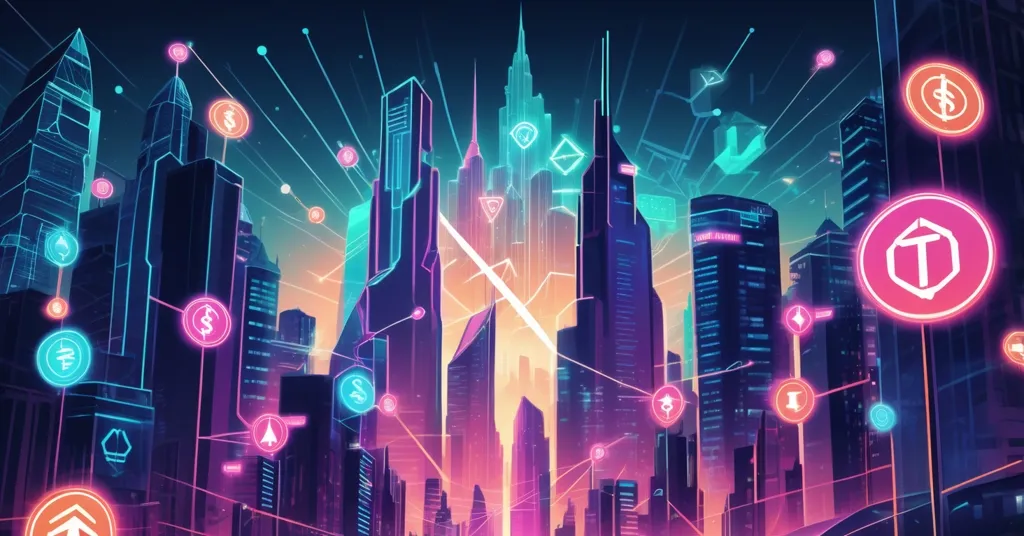Toncoin (TON) 2026 Price Prediction: Could 500 Tokens Hit $4,000? Hype vs. Reality

How Much Could 500 Toncoin (TON) Tokens Be Worth by 2026? Digging into the Hype and Hard Truths
Could 500 Toncoin (TON) tokens transform into a tidy windfall by 2026, or are you just chasing another crypto mirage? With TON’s deep roots in Telegram’s ecosystem—boasting over 900 million users—the potential is hard to ignore, but the road ahead is paved with regulatory traps and fierce competition.
- Current Status: TON trades at $3.02 with a $7.5 billion market cap as of mid-2025.
- 2026 Outlook: Predictions range from $5.06 to $8.10 per token, valuing 500 TON between $2,530 and over $4,000.
- Key Factors: Telegram’s massive reach drives growth, but regulatory risks and security flaws loom large.
TON’s Foundation: A Blockchain Built on Telegram’s Reach
Toncoin, or TON, is the native cryptocurrency of The Open Network, a Layer 1 blockchain designed for speed and scalability. For those new to the space, a Layer 1 blockchain is a base-level network—like Bitcoin or Ethereum—where transactions and apps are built directly, without relying on secondary layers for processing. Originally developed by Telegram, TON was handed over to the independent TON Foundation after regulatory battles forced Telegram to step back in 2020. Today, TON powers a range of features within Telegram’s platform, from instant payments and tipping bots to mini apps and decentralized file storage. With Telegram’s user base exceeding 900 million, TON has a built-in audience that most blockchains would kill for. But does this translate into real value for holding 500 tokens—currently worth about $1,510 at $3.02 each—by 2026? If you’re curious about the broader context of this technology, you can explore more on the TON blockchain’s background.
The numbers paint a compelling picture. As of June 2025, TON holds a market cap of $7.5 billion with a circulating supply of 2.5 billion tokens. Network activity has exploded, with daily transaction volumes climbing from 100,000 in mid-2023 to 1.2 million by early 2025. That’s a massive jump, reflecting growing usage compared to smaller Layer 1s like Near Protocol, though still behind giants like Ethereum. Total Value Locked (TVL)—the amount of money users have staked or invested in TON’s financial apps—has surged from $14 million to $386 million over the same period, signaling trust and engagement in its DeFi ecosystem. Recent updates from the TON Foundation, including the 2025.04 release, have sweetened the deal by boosting validator rewards and cutting gas costs, making the network cheaper and more attractive for developers and users alike. For deeper insights into these updates and their impact on TON’s growth, there are detailed breakdowns available.
Real-world adoption adds another layer of intrigue. A partnership with a Southeast Asian fintech startup lets users convert local fiat currency into Toncoin using stablecoins and liquidity pools, enabling everyday commerce through TON mini apps. Think remittances, small business payments, or even online purchases—all processed seamlessly within Telegram. Meanwhile, Telegram pays ad revenue to content creators in Toncoin, creating a circular economy where users earn and spend within the same ecosystem. Developer activity is booming too, with open-source contributions tripling since early 2024, fueled by events in Singapore and Lisbon that have birthed new decentralized apps (dApps) and tools. Recent news on TON’s partnerships in Southeast Asia highlights the regulatory risks and opportunities in this region.
Technical Edge and Tokenomics: What Fuels TON’s Potential?
Technically, TON stands out with its use of sharding—a method of splitting the blockchain into smaller, parallel chains to process transactions faster, much like dividing a huge workload among many workers. Tests show TON handling over 100,000 transactions per second, outpacing Ethereum’s Layer 2 solutions like Arbitrum or Optimism, and rivaling Solana’s speed. Financial backing doesn’t hurt either; the TON Foundation has raised $400 million from heavyweights like Sequoia and Benchmark, while a new CEO, Maximilian Crown, appointed in April 2025, is steering the project toward institutional partnerships and regulatory compliance. For a technical comparison, check out this analysis of TON versus Solana as Layer 1 competitors.
Tokenomics—how TON’s supply and value mechanics work—offers another angle for speculation. TON uses a dynamic inflation model, minting new tokens to reward validators who secure the network. But here’s the twist: transaction fees and service payments burn tokens, reducing the total supply over time. Picture it like cutting down the number of concert tickets available; if demand holds or grows, each ticket could become more valuable. If TON’s usage spikes—more payments, tipping, or mini app activity—the burn rate might outstrip inflation, creating scarcity and potentially driving price growth. Recent price stability, with TON trading between $2.85 and $3.10 in May 2025 before settling above $3.25, suggests room for upside, though crypto markets are anything but predictable.
TON Price Prediction 2026: Bullish Dreams or Harsh Reality?
With these fundamentals in mind, what could 500 TON tokens be worth by 2026? Analysts from various platforms have thrown out some numbers, and they’re worth dissecting—though not swallowing whole. A moderate scenario pegs TON at $5.06, lifting its market cap to $12.15 billion, roughly where Solana sits during calmer market phases. That values 500 tokens at $2,530, a respectable 67% gain from today’s $3.02. A bullish outlook pushes TON to $8.10, with a market cap of $20.25 billion, rivaling Cardano at its peak. That would make 500 TON worth over $4,000—a nice payoff for early believers. Some even whisper about $25 by 2030, but let’s not drink that Kool-Aid; crypto’s mood swings make such long-term bets pure fantasy. For a detailed TON price forecast for 2026, there are expert analyses available online.
The bull case rests on Telegram’s monetization push. If Telegram doubles down on paid features, ad revenue, bots, and creator tools—all powered by TON—the network’s utility could skyrocket. Growth in DeFi and GameFi, like the tap-to-earn games that went viral in 2024, adds more momentum. Some analysts believe TON could overtake Solana and Binance Smart Chain to become the second-largest smart contract blockchain behind Ethereum by the decade’s end, especially if Telegram’s user base hits 1 billion by late 2025 as projected. On-chain activity supports the optimism: growing wallet counts and transaction burns hint at sustained demand. Community perspectives on this Telegram and TON integration can be found in online discussions.
Before you start counting your profits, let’s slap some cold water on this hype. Price predictions are glorified guesses, often peddled by shills looking to pump their bags. I’ve seen absurd claims—like TON hitting $11.23 in mid-2025 only to crater to $0.06 by year-end—with ridiculous ROI figures like 38,000%. That’s not analysis; it’s snake oil. TON’s price history tells a volatile tale: launching at $4.44 in 2021, tanking to $0.80 in 2022 amid market gloom and regulatory fears, and peaking at $7.25 in early 2024 before cooling off. Banking on a clean $4,000 for 500 tokens by 2026 ignores the brutal reality of market crashes or external shocks. A quick disclaimer: price speculation isn’t financial advice. Crypto is a high-risk game, and past performance means nothing for future results. For a broader take on TON’s potential value by 2026, there are resources worth exploring.
The Dark Side: Regulatory Heat and Security Flaws
TON’s tight tether to Telegram is both its superpower and its kryptonite. Regulatory scrutiny has dogged Telegram for years—recall its forced exit from TON’s direct management in 2020 after SEC pressure, or the 30% price drop following founder Pavel Durov’s arrest in August 2024. Any new crackdown, especially if governments target Telegram for enabling crypto transactions, could gut TON’s value overnight. Look at XRP, which suffered years of price suppression during legal battles with the SEC. TON might face a similar slog if regulators smell blood.
Competition isn’t sleeping either. Layer 1 blockchains like Solana, with comparable transaction speeds, and Near Protocol, with a focus on user-friendly dApps, are vying for the same developers and users. TON’s transaction fees are low—often under a cent—but Solana’s established DeFi ecosystem and NFT market give it an edge for now. Then there’s a nasty thorn in TON’s side: security. A January 2025 study by TONScanner uncovered over 14,800 bugs in 1,600 smart contracts written in TON’s FunC programming language. That’s a glaring vulnerability. Without aggressive audits or bug bounties, developers and users might hesitate, stunting growth. One high-profile hack could be catastrophic—trust is hard to rebuild in crypto.
Where Does TON Fit in the Crypto Revolution?
As a Bitcoin maximalist, I’ll be blunt: TON isn’t Bitcoin. It’s not the unassailable, censorship-resistant store of value we hold as the gold standard for financial sovereignty. Bitcoin’s mission is pure—decentralized money free from meddling hands. TON, by contrast, plays in a different sandbox, prioritizing scalable, user-friendly dApps and microtransactions tied to a centralized platform like Telegram. That centralization rubs against pure decentralization ideals, no question. But let’s give credit where it’s due: TON fills a niche Bitcoin doesn’t touch. It’s pushing everyday usability—think tipping a creator on Telegram in a split second, no banks, no fees—which aligns with the broader fight for financial freedom in its own messy way.
If you buy into effective accelerationism—the idea of speeding headlong into tech-driven progress to disrupt the status quo—then TON’s aggressive growth is a fascinating experiment. Its access to Telegram’s user base, blistering speeds, and real-world use cases make it a contender among altcoins. It’s not about replacing Bitcoin but complementing the ecosystem, carving out spaces for innovation that BTC, by design, shouldn’t chase. Still, that Telegram linkage is a double-edged sword, and it’s hard to ignore the contradiction of a “decentralized” blockchain so reliant on a single app’s fate.
Key Questions and Takeaways on TON’s Future
- What’s fueling TON’s potential value growth by 2026?
Telegram’s 900 million users, network upgrades slashing costs, and rising adoption in payments, DeFi, and GameFi are the big drivers. Analysts tie price upside to Telegram’s monetization efforts and ecosystem expansion. - What are the major risks threatening TON’s price?
Regulatory heat from Telegram’s past and present issues could tank TON, alongside over 14,800 smart contract bugs that threaten security. Competition from Layer 1s like Solana adds another layer of pressure. - Is investing in 500 TON a wise move for the long term?
It’s a speculative bet at best. A range of $2,530 to $4,000 by 2026 is plausible in bullish markets, but volatility, regulatory shocks, and security gaps make it a risky play, not a sure thing. - How does TON contribute to the broader crypto mission?
TON advances decentralization through accessible dApps and mass user onboarding via Telegram, supporting financial freedom in areas Bitcoin doesn’t prioritize, despite its centralized ties.
So, where does that leave 500 TON tokens as we look toward 2026? It’s a high-stakes wager with intriguing potential if Telegram’s ecosystem delivers and TON patches its flaws. But don’t delude yourself—crypto isn’t a lottery ticket, and TON’s path is riddled with pitfalls. For newcomers, treat it as a speculative slice of a portfolio that starts with Bitcoin. For seasoned players, it’s a compelling case study in blending centralized reach with decentralized tech. Either way, keep your skepticism sharp: will TON genuinely democratize finance through Telegram, or is it just another altcoin surfing a wave of hype? Only time will tell, and the clock’s ticking.



